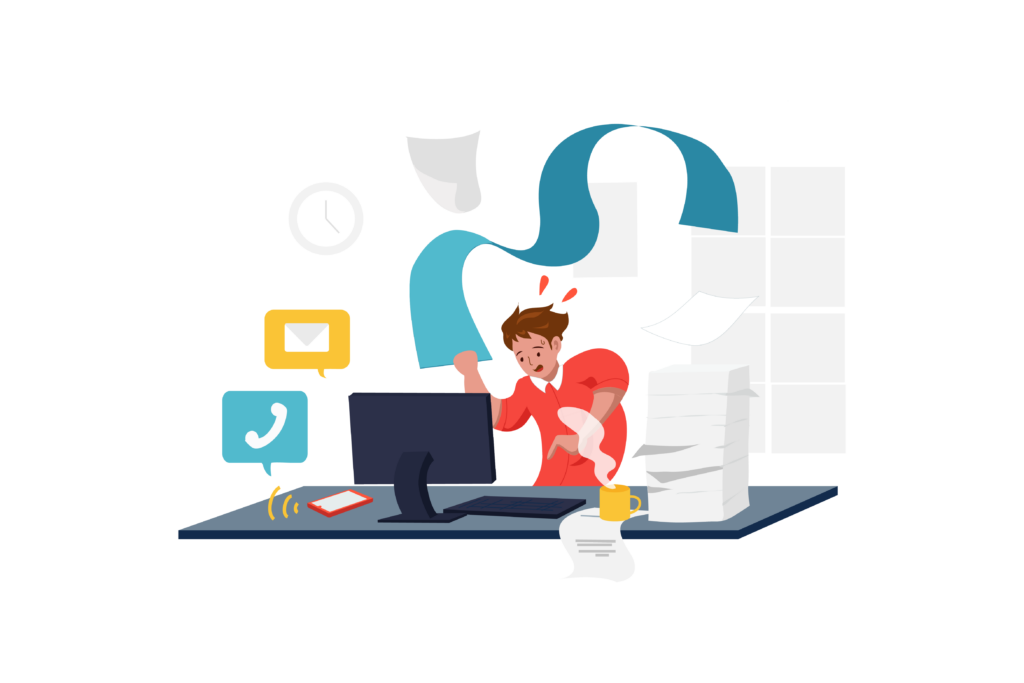Collaboration and teamwork are the basic pillars of success at both organizational and individual levels in the interconnected, global, cross-functional world of business. We talked a lot about collaboration and how beneficial it is to an organization’s productivity and success. However, as with any other phenomenon, if misused, it can have negative consequences. So, in this article, we’ll discuss collaboration overload and how you can avoid it.

What is collaboration overload?
Collaboration overload occurs when multiple team members work extensively and collectively on a single issue. Individuals collaborate so frequently that it negatively affects their productivity and wellbeing. It can be caused by a variety of factors, including:
- Too many unproductive meetings,
- Excessive emailing,
- Too many people working on the same project at the same time,
- Duplication of effort, or
- Being responsible for answering colleagues’ questions at all times.
When this happens, team members may feel overwhelmed with communication and decision-making responsibilities. This usually leads to a reduction in job efficiency and production. All of these collaborative responsibilities can become distractions, preventing people from performing the work they need to do on their own or actual collaborative work. Therefore, employees often carry unfinished work home which prepares the ground for burnout.
A recent article in Harvard Business Review demonstrated that over the last decade, collaborative work, time spent on email, instant messaging, phone calls, and video chats, has increased by 50 % or more, consuming 85 % or more of most people’s workweeks. People are spending more time each week in shorter and more fragmented meetings as a result of the Covid-19 pandemic, with voice and video call times doubling and IM traffic growing by 65 %. To make matters worse, collaboration expectations are becoming more common in the late afternoon and early morning.
These demands, which managers often overlook, are impeding companies’ attempts to become more flexible and innovative. Individual career derailment, burnout, and reductions in physical and mental well-being are all possible outcomes.

Early signs of collaboration overload
There are a few signs that are typical to an organization experiencing collaboration overload. Here are some of them:
1. Too many meetings
A good indicator of whether or not you’re at the risk of collaboration overload is the number of meetings within a team or the company. Your employees may not necessarily have a lot of tasks to perform but the endless meetings required for these tasks can easily increase their workload. According to cognitive science, it might take up to half an hour to refocus and return to full speed following a conference or phone contact. Small distractions can be detrimental since they force us to take a break from the activity at hand, pushing us to re-enter the flow of work.
Take a moment to look at the collective calendar of your team and understand how many meetings you hold per week, what the objectives of these meetings are and whether they were an absolute must.
2. Burnt out employees
Collaboration necessitates a significant amount of effort from both the group as a whole and each team member individually, which can result in increased work for employees. It may be difficult for team members to participate successfully in all of their roles. Employee burnout can occur as a result of the added stress and frustration. So, if you have employees coming to you with this issue or you recognize that they are burnt out, do take a closer look at the collaboration patterns within your company.
3. Tension during group meetings
As a manager, you need to have a strong emotional radar and look beyond the conversations that take place in a team meeting. One of the symptoms of collaboration overload is tension and it has a tendency to surface during group meetings. So “turn on your 6th sense” and if you spot tension, dig deeper to understand its causes and put the collaboration practices under a microscope.

Consequences of collaboration overload
If not caught and eliminated early, collaboration overload can have very dangerous consequences for the company. Let’s take a closer look at some of them:
Individual performance and decision-making
It may sound like a paradox, but collaboration overload can lead to working in silos. There are two primary reasons for that:
- Slow decision-making process because there are too many meetings, opinions and actors involved.
- An increased need to work alone.
Since collaboration encourages others to offer recommendations and opinions, the time it takes to make a conclusion can be extended. So, when you have a collaboration overload, the decision-making can take a very long time and put the work on hold.
The other one is not so much related to work and tasks. It’s more of a human need. Even the most extroverted person needs time to themselves.
Micromanagement
There is a turning point in collaboration when it becomes micromanagement among team members. Having checks and balances within the company and diversity of opinions is great. However, when you have collaboration overload, it paves way for micromanagement. Colleagues are cc-ed in each other’s interactions, they feel “encouraged” to share pointers and opinions about someone else’s work. Similarly, having these opinions all the time hinders independent thinking and working, and you may have employees that seek advice and assistance at every turn.
Pressure
Employees may feel under pressure to answer every message and email if there is an overemphasis on involvement and participation in the workplace. This is a classic example of collaboration overload and reduces the actual productive work time within the company. On the individual and emotional level, this pressure can be particularly difficult for introverted team members.

How to prevent collaboration overload?
If you’re a manager, a small business owner, or a team lead, here are some strategies to use to avoid collaboration overload and boost staff retention.
1. Asynchronous collaboration
Asynchronous communication is a great approach to boost productivity and cut down on excessive collaboration. As the name suggests, asynchronous collaboration means that your team members can work at different times as long as they complete their tasks on time. This creates a work environment and a collaboration climate that doesn’t require immediate attention or action. For example, instead of sending someone an email or instant message asking for a quick response when you only need the answer later, send them a text and ask them to respond when they have time.
This work mode allows all parties involved to complete their tasks without frequently interrupting one another. You simply avoid receiving (and sending) endless messaging notifications every day by using this mode and still maintain productive team interactions. You may take it a step further by incorporating silent meetings into your collaboration.
2. Clear workflow
To avoid having too many individuals working on the same project, it’s critical to develop a simple workflow. A well-defined process can help avoid unnecessary meetings and ensure that everyone understands their responsibilities and tasks. The clear workflow also helps employees better manage their time outside of work.
Use checklists to keep team members organized and on track, reducing the likelihood of work being forgotten or duplicated. Introduce and utilize task management tools that also allow you to share comments and updates with one another hence reducing the need for online meetings.
3. Setting aside focus hours
This, in our opinion, is one of the most if not THE most effective ways of preventing collaboration overload. It’s a simple notion but it can work miracles. Each employee gets to set their own focused work time and during this period they are unavailable for other assignments or calls unless there is an emergency. Have them block these time periods on the shared calendar so everyone is updated on each other’s schedules.
In a similar fashion, you can also encourage your employees to set hours during their workday when they answer emails. This comes to replace the constant need and urge to check their inboxes. It significantly reduces the pressure to answer immediately and leaves room for more focused and productive work. Again, these time frames need to be available and accessible to the other team members so they know when to expect an answer.
4. Leave online calls as the last resort
Constant calls are a leading cause of collaboration overload. They take a lot of time and energy which could be invested in more important matters. So, carefully monitor how much time your teams spend on online calls and make reductions if necessary. Pretty much any call can be summed up in an email unless you need to brainstorm or manage a crisis. So do make sure you leave calls as a last resort.
We also recommend setting a weekly limit for the number of meetings that can be arranged between employees at the company level. This limit helps become more conscious and think twice before scheduling a call. It’s like having ⅔ strikes while playing Mario. You’re a lot more focused and mindful of how you’re playing.
And last but not least, make sure that only the employees whose participation is critical at specific meetings are invited to the call. This saves time for personnel who have no direct involvement with or accountability for a project.
5. Treating the symptom, not the disease
Before you go, we’d like to bring one last thing to your attention. Very often than not, collaboration overload is a sign of a deeper and more complex issue that usually lies within the organizational structure. The never-ending flow of messages, emails, and 5 calls a day are simply means to an end. People are trying to work and if they’re doing so with a collaboration overload then you need to take a closer look at your operating model. Read more here to learn more about collaboration overload in the context of a larger organizational issue.
Just like in any other aspects of life, business, and beyond, the key to success is balance. Collaboration is an excellent working model that utilizes strengths, brings in a diversity of opinions, and leads to great products. However, for it to work, you need a good balance between working independently and working together.
In the workplace, collaboration overload can be a serious problem. With these pointers in hand, eliminate collaboration overload while still fostering productive workplace interactions. You can keep your team working peacefully together toward common goals by recognizing the signs of collaboration overload and taking steps to address them.
Contact our team to learn how to improve your collaboration processes at scale

